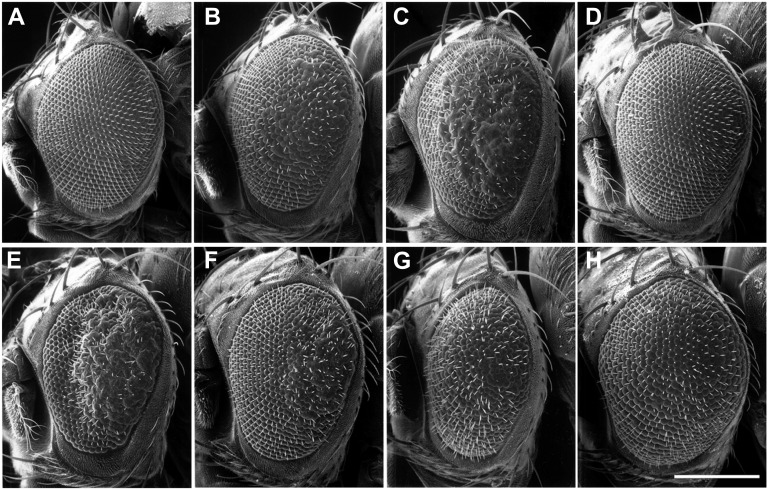Figure 1 .
Tissue-specific expression of dE2f1-dsRNA generates phenotypes that can be modified by known factors of the dE2F1 pathway. (A) A normal Drosophila eye (w1118; GMR-Gal4/+; +/+). (B) Expressing one copy of the UAS-dE2f1-dsRNA (Line #10) generates a slight rough eye phenotype (w1118; GMR-Gal4, UAS-dE2f1dsRNA#10/+; +/+), which can be enhanced by reducing the endogenous dE2f1 levels, as shown in (C) (w1118; GMR-Gal4, UAS-dE2f1dsRNA#10/+; dE2f1i2/+), and completely rescued by overexpressing wild-type dE2f1, as shown in (D) (w1118; GMR-Gal4, UAS-dE2f1dsRNA#10/+; UAS-dE2f1+/+). A stronger rough eye phenotype is generate when multiple copies of UAS-dE2f1dsRNA (line #8) is expressed, as shown in (E) (w1118; GMR-Gal4, UAS-dE2f1dsRNA#8/+; +/+). This stronger phenotype can be suppressed by overexpressing wild-type dCycA (F: w1118; GMR-Gal4, UAS-dE2f1dsRNA#8/+; UAS-dCycA+/+), wild-type dCycE (G: w1118; GMR-Gal4, UAS-dE2f1dsRNA#8/UAS-dCycE+; +/+), or dCdk4 and dCycD (H: w1118; GMR-Gal4, UAS-dE2f1dsRNA#8/+; UAS-dCdk4+, UAS-dCycD+/+). The scale bar (in H) is 200µm.

